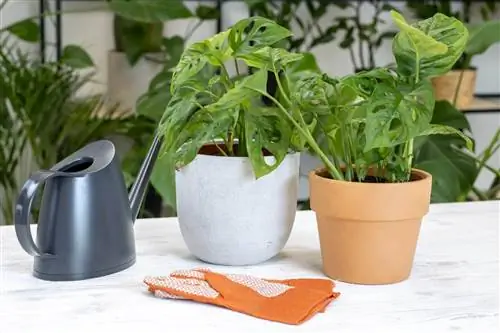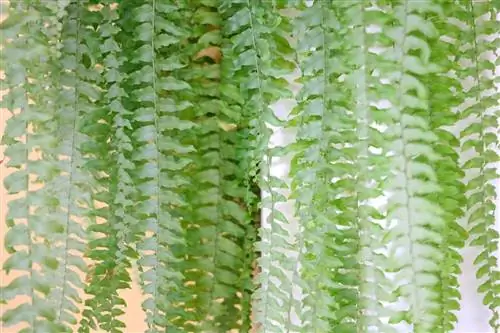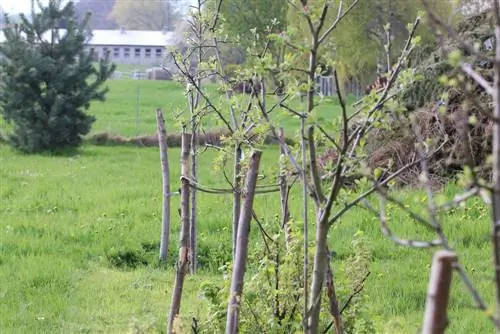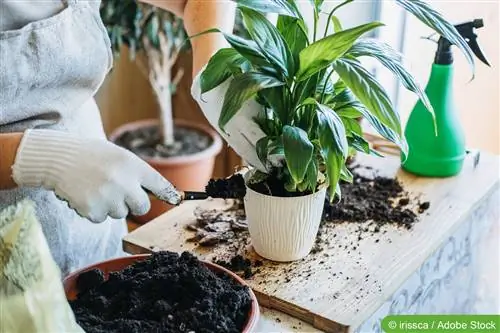- Author admin [email protected].
- Public 2023-12-17 03:39.
- Last modified 2025-01-24 12:45.
Houseplants bring life and warmth into your own four walls. Even bare office spaces lose their desolation thanks to the plants, while at the same time the room air is enriched with important oxygen. However, it should not be ignored that houseplants also have certain requirements in terms of care and location. Especially in the cold season, the plants in the pot need much more attention than in summer. Make sure that the plants are decorative and he althy on the windowsill.
Consider basic needs
Hobby gardeners who have been successfully cultivating houseplants for years know that each type of plant has its own requirements and needs. While one variety thrives in an airy stairwell without any problems, another variety reacts to drafts by losing leaves. And you don't always have to pick up the watering can as soon as the soil has dried. Although there are some guidelines for the ideal care of houseplants, you should still take into account the specific basic needs of each individual variety. This includes choosing the right location as well as the correct watering and fertilizing behavior.
In order to avoid care mistakes or even eliminate a problem that has already occurred, you should “know” your houseplants. For certain exotic plants, it is even advisable that you know their exact botanical name. Even the representatives of one plant genus can have completely different requirements. For example, the common name “three-masterflower” includes a variety of different plants from the commeline family. While Tradescantia Andersoniana can be cultivated directly on bank edges, Tradescantia pallida reacts sensitively to such a moist substrate.
Finding the right location
It is not possible to make a general statement about which plant varieties need a sunny location and which of them also make do with shady places. However, there are some basic tips:
- Plants with colorful or patterned leaves require a full sun location
- direct proximity to active radiators dries out the plants too quickly
- give large plants enough space
- tie up or support climbing shoots
- many exotic plants require high humidity
Some plant species are extremely sensitive to cold; even cool window sills can inhibit the growth of these plants. Protect the roots by placing an insulating Styrofoam plate under the flower pot. Even in very dark rooms or in a basement apartment, you don't have to forego cultivating light-requiring houseplants. Use special lamps from specialist retailers and create your own green oasis of well-being in your own four walls. A lack of light leads to undesirable rotting of many houseplants. The shoots literally “shoot up” and grow towards the light. In addition to the unsightly appearance, this uncontrolled growth also weakens the plants. This can be quickly remedied by moving the plants to a brighter location and shortening the “horny shoots” by 2/3.
Wellness tips for the summer months
As soon as nature awakens outdoors, the main growing season begins for many of our houseplants. As early as mid-March, the plants are watered normally again and the important supply of nutrients begins. There is a trick you can use when watering potted plants: do the finger test. Use your index finger to check how the top layer of substrate feels. If it has a dry, slightly crumbly consistency, add more water. Make sure that the root ball of the plants does not dry out completely.
By choosing the right fertilizer, you can not only promote the growth and he alth of your plants. Phosphate, for example, ensures increased flowering. Organic household fertilizers are only partially suitable for houseplants. Coffee or tea grounds must be properly incorporated into the substrate when dry to avoid mold formation. But not every product from the garden center is suitable for every type of plant. In cacti and bonsai plants, a high proportion of nitrogen inadvertently promotes growth. You should therefore only supply exotic breeds and varieties with a special fertilizer. The more houseplants you cultivate, the more difficult it is to keep track of the correct, variety-specific amount of fertilizer. Follow the package instructions and the motto: Less is more. A look at the plants themselves is usually enough to see whether and when they need to be fertilized. However, don't let it get to the point where the plant visibly suffers from a lack of nutrients. But an oversupply of fertilizer can also trigger these signs.
Use early spring to move older plants into fresh planters and to take cuttings. As soon as the temperatures rise, you can treat a variety of houseplants to a stay outdoors. Slowly acclimate the plants to direct sunlight to avoid leaf damage. This can be done, for example, with a parasol. Or bring the plants back into the house during lunchtime for the first few days. Don't panic if the foliage has already changed color, because the newly sprouting leaves will have their original color again.
Safe and pest-free through the winter
Even in the cold season, houseplants cannot and should not be left to their own devices. Many species take some sort of vegetation break, so you should consider some basic winter tips:
- Avoid drafts.
- Stop fertilizing completely.
- Do not move unnecessarily.
- Avoid repotting during this time.
- Watering moderately.
Room air that is too dry not only affects our mucous membranes, but can also be dangerous for houseplants. Even if individual plants do not require high humidity, you should place a container filled with water in the rooms. From a decorative indoor fountain to an open aquarium to a mundane bowl filled with water, everything is allowed. At the same time, this prevents an infestation with spider mites, which prefer the dry and warm indoor climate in winter. Alternatively, you can regularly wet the plant leaves with water using a mister. However, this method can lead to unsightly discoloration on some plants.
Treating and preventing diseases
Caring for houseplants also includes regular checks for pests and fungi. Because harmful insects and other diseases do not stop at our four walls. Aphids feel just as comfortable on the plants as spider mites, fungus gnats and mildew. You should avoid using insecticides or fungicides when fighting the disease. Rather, use natural home remedies, such as soapy water or nettle decoction. Affected or infected plants must be separated immediately to prevent the rapid spread of the disease or pests.
Tip:
Clean your hands and the tools you use before and after working on the houseplants. The majority of germs and eggs are transmitted through direct contact with contaminated plants.
Conclusion of the editors
Houseplants bring life into your own four walls. Even bare rooms can be transformed into an oasis of well-being with just a few green plants. The selection of container plants is large, but even robust and relatively undemanding plants should by no means be left completely to their own devices. However, it is often enough if you pay enough attention to the plants and check them regularly.
Common mistakes when caring for houseplants
Waterlogging
Very few plants in households dry out. It happens much more often that the plants literally drown. Watering too frequently leads to waterlogging of many plants and thus to root damage caused by rot. Therefore, it is better to water moderately but regularly. The finger test can help determine the right amount of irrigation water. Only water when the surface of the soil and the layer about 1cm below it feel dry. If the soil is moist, it is better to wait a few days before watering.
Wrong location
When buying houseplants, it is absolutely necessary to find out which location the respective plant prefers. Spider plants, for example, also tolerate dark, cool locations, while Ficus Benjaminii enjoys light, but direct sun should definitely be avoided. Some plants react to a change of location by dropping leaves (Ficus Benjaminii, for example). Hardly any plant is happy about drafts. In the hallways where doors are often opened, you should perhaps avoid plants altogether or opt for the artificial version.
Too much or too little fertilizer
Green plants also need nutrients and do so at regular intervals. If you only fertilize sporadically, you have to expect that your plants will eventually look stunted and unhe althy. Regular fertilization, as required and specified, ensures strong growth and he alth. Resistance to diseases and pests is also important for plants. However, too much fertilizer is not good either. Overfertilization often causes root damage (burns), but this is not initially visible. The visible consequences such as leaf drop, spotty, brown or even mushy leaves only become apparent much later. However, when the time comes, it is usually too late for the plant. If you are not sure how often and with which fertilizer you should supply your plants with nutrients, you can find out more not only in specialist books but also on the Internet.






